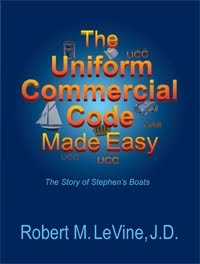Now that the
‘agreement’ is in place, we refer back to the definition of ‘contract’ to
determine the legal significance of the agreement. This is no small task, since it involves the
application of the UCC to the totality of the facts, and thereafter the application
of any supplemental principles of law.
With the recognition that Article 1 applies to every transaction under
the Code, there are other powerful provisions which must be addressed before
moving into the substantive Articles.
First among
these provisions, is the obligation of good faith which is stated in Section
1-304. That section reads as follows:
Every contract or duty within
the Uniform Commercial Code imposes an obligation of good faith in its
performance and enforcement. [Emphasis
added]
That is a very powerful and obviously
extremely pervasive provision. What
exactly does it mean, and what happens when the standard of good faith is
breached?
At
the outset, it is clear from the language of Section 1-304 that the good faith
requirement applies not only to the execution of the contract, but to all
‘duties’ which arise under the Uniform Commercial Code. These duties are pervasive throughout the UCC
and will reveal themselves through the utilization of the comprehensive
approach to the Code. The comprehensive
approach was discussed in the March 16th and March 19th
posts.
In
analyzing the impact of the good faith requirement, it is important to remember
that the definition of ‘good faith’ among the various jurisdictions is not
uniform. Hence, in some jurisdictions—Illinois for example—good faith remains ‘honesty
in fact in the conduct or transaction concerned’. The majority of states, however, have adopted
the amended definition of ‘good faith’ which states:
“Good faith,” except as otherwise provided in
Article 5, means honesty in fact and the observance of reasonable commercial
standards of fair dealing. Section 1-201(b)(20)
Therefore, in addition to ‘honesty in fact’
parties, under the amended definition, are required to observe reasonable
commercial standards of fair dealing. The difference is significant. According to the comments of Section
1-201(b)(20) the amended definition is to be read as including:
‘both the subjective element of honesty in fact and
the objective element of the observance of reasonable commercial standards of
fair dealing.”
My preference is
the unamended version of ‘good faith’.
While I certainly believe that all professionals should be required to
act in a commercially reasonable manner, I do not believe that consumers should
be held to the same standard as a professional in the business, particularly
when the consumer is unsophisticated in commercial transactions and conducting
himself ‘honestly in fact.’ Those states
that have not adopted the amended definition of good faith have not abandoned
the concept of commercial reasonableness as it pertains to professionals in the
business. Thus, under Article 2 for
example, Section 2-103(1)(b) incorporates ‘the observance of reasonable
commercial standards of fair dealing’ in the trade as well as honesty in fact
if the person involved is a merchant.
The varying
definitions might be of great significance in multistate transactions, and
attorneys drafting documents for such transactions, or selecting the law to govern
their transaction, should check the definitions of the states involved and
select the one that best protects the interest of his or her client.
Another
important element of good faith is that it is factual in nature. Therefore, where an allegation of lack of
good faith has been properly made in court, summary judgment should rarely, if
ever, be granted. While in law school, I
did a research paper on the significance of good faith under the Uniform
Commercial Code. I read every case in which good faith was discussed, and among
the many things I learned was that every case in which summary judgment was
granted where a lack of good faith was alleged, was reversed.
There are no
specific consequences stated in the statute for the failure to act in good faith.
The comments however state as follows:
This section
does not support an independent cause of action for failure to perform or act
in good faith. Rather, this section means that a failure to perform or enforce,
in good faith, a specific obligation under the contract constitutes a breach of
that contract or makes unavailable, under the particular circumstances, a
remedial right or power.
Case law has consistently followed this
language, insofar as the creation of an independent cause of action. However, as you will see in the next post,
even though courts have not recognized an independent cause of action for a
breach of the duty of good faith, punitive damages claims have been allowed by
some courts for a breach of this duty.
For more information on the author and book,
please visit ucc-madeeasy.com.
